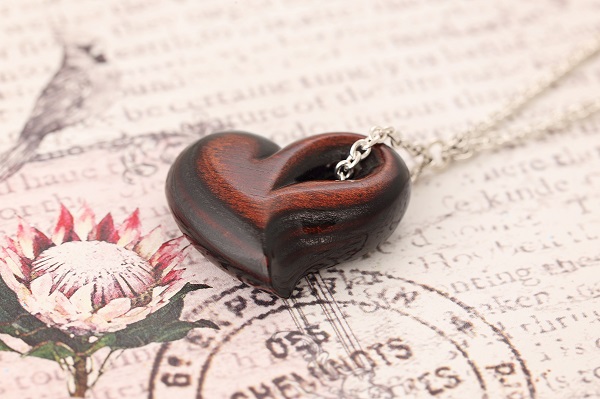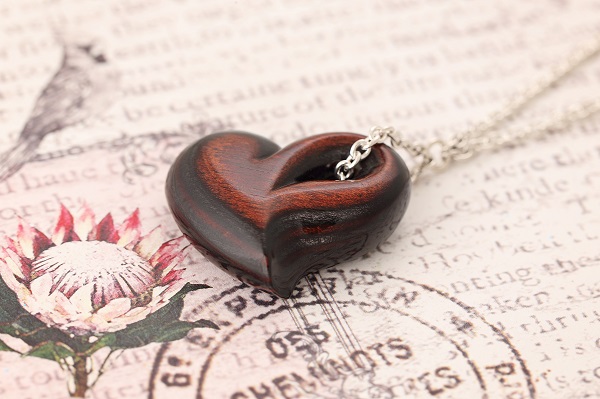Your basket is currently empty!

Working with wood
Every now and then a jeweller will have the opportunity to work in wood. Wood is classified as a non-gem, organic material.
Wood appeals to people who want to accessorize with more natural materials. Wooden beads and bangles work well with Boho-chick styles, and men especially love the masculine look and feel of wood in rings and bracelets.
As with anything natural, wood is warm to the touch and seems to emanate calm and peacefulness. Wood is also light and inexpensive compared to metal, and large pieces can be made and worn comfortably to body and budget.
More than anything, wood is beautiful. Wood comes in colours from deep red to almost black, and every hue of yellow and brown you can think of. The texture, wood grain and knots of some species add further interest and beauty, especially if the artist knows how to exploit them to fit the project.
Types of wood that are suitable
Almost any wood can be used in jewellery, as long as it is strong and durable enough. The wood you choose must not dent, split or splinter too easily. Apart from that, the artist will choose wood based on whether it shows attractive colours or wood grain, or if the wood takes dyes or stains better, or if it can be polished to a high shine, or whatever the outcome is that the artist desires.
Hardwoods vs Softwoods
Do not be confused with the terms hardwoods and softwoods. Very simply put, hardwoods are trees that reproduce with flowers and have broad leaves (angiosperms), as opposed to softwoods which reproduce with seeds (gymnosperms) – often in the form of cones or nuts – like pines, firs and spruces.
Although it is true that hardwoods often take longer to grow, resulting in a denser and harder wood, the words hardwood and softwood do not necessarily refer to the hardness or softness of the wood. There are in fact hardwood species that are much softer than some softwood species.
Because softwoods like pine grow quickly, it can be grown in plantations, mainly for the construction and paper industries. As such, these are not considered very “glamorous” woods to use in art and jewellery, which is probably the bigger reason why jewellers may rather turn to the rarer hardwood species.
In Africa, we are blessed with quite a few hardwood species that are absolutely beautiful to use in jewellery. Examples are: red ivory, wild olive, tamboti, matumi, african blackwood, mopane, camel thorn, red bushwillow and more…
Engineered woods
Engineered woods are when thin slivers of wood (veneer) are pressed and glued together to form one layered piece of man-made wood. Laminated wood and plywood are examples of engineered wood products.
Note: Laminated woods and plywoods are manufactured for many industries, including the building industry, and some of these products will not be suitable for jewellery making. Laminated wood flooring, for example, is not wood at all, but layers of synthetic materials bonded together and designed to look like wood.
Engineered woods are strong because the wood grain, which is the weak parts in a solid piece of wood, do not run through the entire block, but only as deep as each layer, and is bonded to the next layer with glue. Engineered woods are also impregnated with resin to further strengthen the whole piece.
Engineered woods are particularly popular with knife and pen makers. They are stable and durable and can be polished to a high gloss. Sometimes manufacturers dye the alternating layers to bright, contrasting colours, and the effect can be rather striking when the lower layers are exposed through shaping the object, as shown in the heart pendant below.
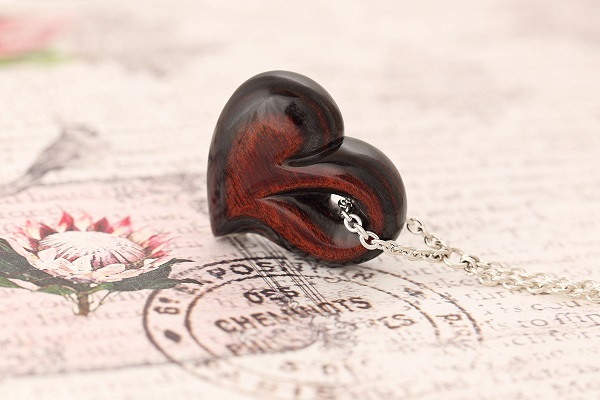
Where to get wood
If you do not know which woods or engineered woods will work for your project, it is a great help to ask for advice from your wood supplier. This brings us to: where to buy wood?
Getting wood is not as simple as felling a tree in the veld and starting to work on it. Apart from the obvious back-breaking work involved, knowing which parts of the tree is suitable takes an expert. Also, living wood is moist and it needs to dry, either outdoors for a few months or in a kiln. Drying is essential to prevent unequal shrinking and warping later.
Saw mills
Logs are sold to saw mills, who sell them on to wood workers of all kinds. Some saw mills specialize in cutting blanks for wood carvers, wood turners, musical instrument makers, artists etc. These specialist saw mills should be able to supply you with smaller quantities and the sizes that you specify, and they are often very helpful when it comes to advice.
Knife making tool suppliers
Knife makers buy their materials from specialist stores. Apart from stainless steel blanks and knife making tools, they also supply every material available from which knife handles can be fashioned, including organics like horn, bone and of course wood and engineered wood. Wood that is suitable for knife handles are definitely suitable for jewellery making and what’s more, you can buy them here in manageable sizes.
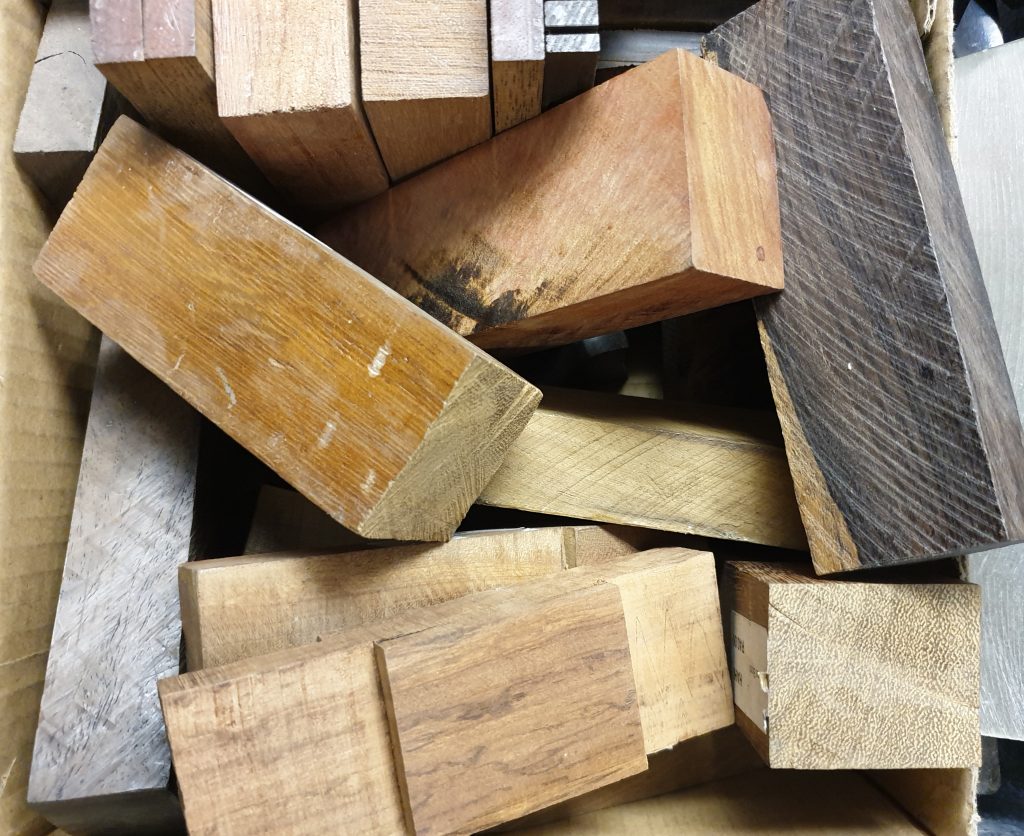
Lastly, you can choose to support sawmills and suppliers who know the origin of the woods they sell, and adhere to the requirements set out by CITES for the responsible and sustainable harvesting of wood.
Design stage
When working in wood, some things need to be considered right from the beginning, at the planning and design stage. The most important consideration is that wood cannot withstand heat of any kind, therefore incorporating it into a fine jewellery piece will require it to either be glued or joined with a cold join like riveting, or both.
Also remember that even though some woods will remain strong in thin pieces, the risk of it splitting does become higher the thinner you go. Thin pieces can be supported at the back with metal.
The wood and buffalo horn pieces in the men’s rings below are supported on the inside by a metal sleeve, and is secured on either side by two metal bands. The whole ensemble is then essentially riveted together with the sleeve acting as a tube rivet. As an extra precaution, the wood and horn is glued to the sleeve to discourage it from rotating, though a tight fit should be enough to keep it in place.
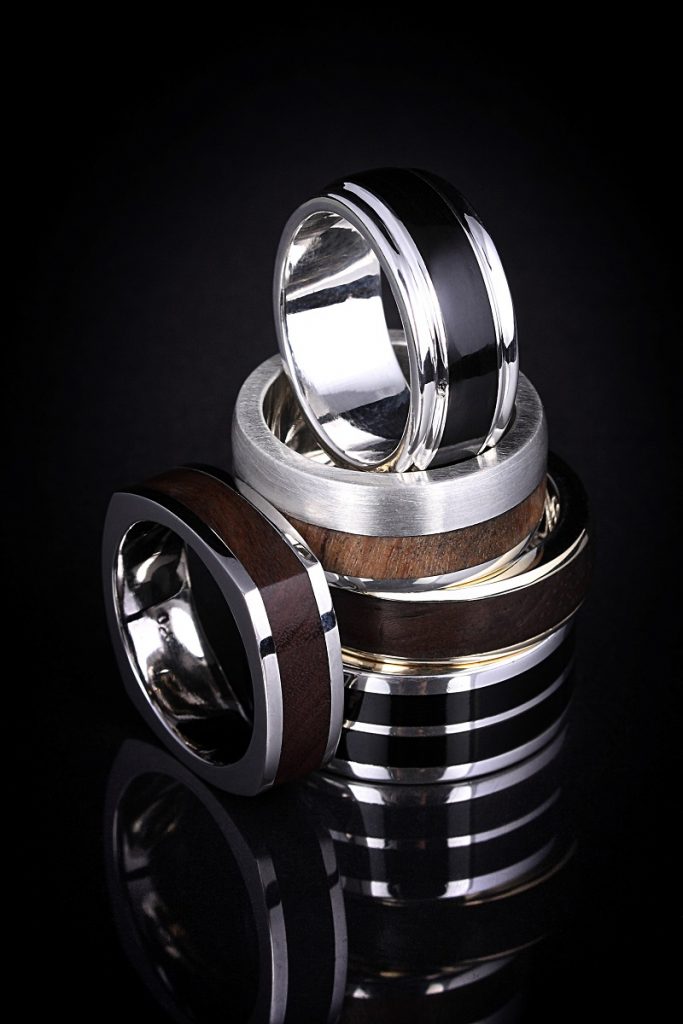
Shaping
Jewellers are confident with hand tools, and switching from metal to wood should be no big deal, though there are a few things that is good to know before you start.
Although wood is soft enough to be shaped with jewellery tools, it really can be hard work to hack through a bigger chunk of plank to get it to more of a jewellery-sized piece to work with. If the piece is very large, a band saw can get through a chunky piece fairly quickly. If you do not have access to this kind of equipment, buy the smallest pieces of wood you can get a hold of, and saw through it by clamping the wood in a vice and sawing with a coping saw.
Further rough shaping can be done with a rasp, which is basically a coarse hand file for wood, or with course grit sandpaper on a belt / disc sander if you have access to one.
Round wooden beads are shaped on a lathe, another piece of specialist equipment, unless you can modify your flexible shaft drill into a hand-held lathe.
For finer shaping, normal jewellery files, drills, abrasive discs, sandpaper mandrels and cutting burs will work great on most woods. Tungsten burs may last a bit longer when you work on denser woods, which will quickly blunt your steel burs.
Other small tools to try are the rotary tools sold at general hardware stores. These are designed specifically for woodwork and should fit into the chuck of your flexible shaft drill, though they may be too big if you use a quick release hand piece.
Finishing
As with metal, after you have achieved the shape that you want, you will need to sand the wood down with gradually finer grit sandpaper to make the surface smooth. 360 grit is probably fine enough for the final sand. Your final sand should flow in the direction of the wood grain and the sandpaper marks should not be visible anymore.
After sanding the wood can be painted, polished or waxed to achieve the final finish that you want. Products to achieve the finishes discussed below are available at hardware stores and instructions on how to use them will vary from brand to brand.
Wood stains
Wood stains contain pigment or dyes which can be used to colour the wood to look like a different species altogether, or to colour it to a completely unnatural wood colour like yellow or blue. The colour seeps into the top layers of the wood and the more porous the wood (pine for example), the easier to stain.
Depending on the product, wood stains can either be applied directly to the wood before adding a sealant, or it can be mixed with the sealant and then applied.
Pyrography
Pyrography is a technique by which wood or other materials like leather is burnt with a tool to create designs or patterns.
Modern pyrographers use a tool with a heated tip that looks like a soldering iron and that can be held like a pen for good control. The tips of a pyrography pen is heated either with an electrical element or with a flame fueled by butane (lighter fluid).
A wide range of hues can be achieved in this way from black to shades of brown. Pyrography art can also be “coloured in” with a wood stain to further deepen shading and create contrast. The effect can be like that of sketching on wood, and amazingly intricate designs can be produced.
Sealing the wood
Durability is a concern when using wood in jewellery. Wood should be sealed with a product that leaves a film over its surface to prevent soiling and to repel water.
Sealing is done by applying a wax, oil or varnish. These are not usually coloured, though some products do combine it with stains and even perfume. The sealant will penetrate into the the top layer of the wood, enhancing its natural colour. Depending on the product, the finish will either be matt or glossy.
Before sealing, the wood surfaces should be smooth, clean and free of dust and other particles.
Furniture waxes and oils
Furniture waxes and oils are easy to apply and will help repel water.
After applying the liquid with a cloth or Scotch-Brite™ pad, the product is left to seep into the wood for a bit. The wood is then buffed with a clean cloth, leaving a shiny but not an overly glossy finish.
Waxes and oils can be reapplied periodically. Over time a build-up of oil may occur, which is easily removed with an equal part mixture of white vinegar and water. After removing, reapply a fresh coat of oil.
Waxes and oils are probably the most practical sealant to use in jewellery, especially when the wood is combined with metal. If the oil spills onto the metal parts of the piece it can be rubbed off, where varnishes are much more difficult to clean off.
Varnishes
Though a bit more cumbersome to apply, varnishes are impenetrable when done properly and will protect wooden surfaces for a long time.
Ideally, varnishes should be layered up, lightly sanding the previous layer of varnish with fine sandpaper and cleaning off the dust with mineral turpentine before applying the next layer. This can be a time-consuming process because each layer has to dry before it can be sanded. Varnishes can be three layers or more deep; the final layers do not have to be sanded.
Varnish is applied with a paintbrush and can be glossy or matt.
Conclusion…
Wooden jewellery is not really something that can be mass-produced. They are mostly worked by hand, and each piece of wood, even from the same species of tree, will have features and colouring that is unique to that piece.
For this reason, although wood in itself is not considered a precious material, wooden jewellery are special items, more so when one can appreciate the skill and work involved in making them.
